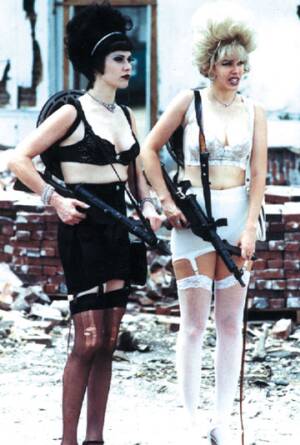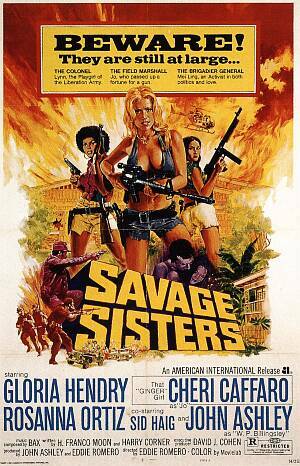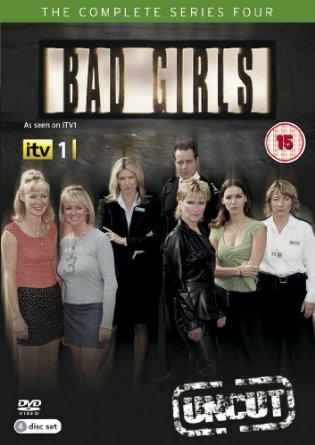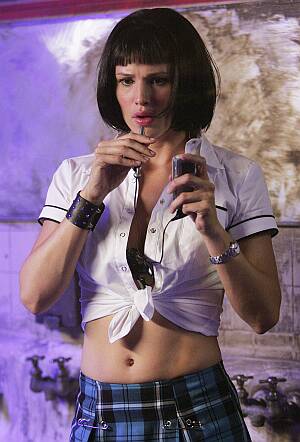★★★½
“Couldn’t put it better than the tagline: Apocalypse Meow!”
 After civilization’s collapse, men have regressed to the level of Neanderthals, while women live in clans decided by their hair colour, with names like the FayWrays, Satanas and Tempests. Clothing is in short supply: lingerie, it would appear, is not, and nor are large, automatic weapons. Unsurprisingly, this leads perhaps to the finest opening five minutes in girls/guns cinema ever – “My name is Rachel, and I am a blonde. Blondes are extinct” – as our heavily-armed, suspender-and-stiletto clad heroines stagger round a post-apocalyptic landscape. This looks fabulous, and totally belies the fact that it cost $16,000 and was made in sixteen days.
After civilization’s collapse, men have regressed to the level of Neanderthals, while women live in clans decided by their hair colour, with names like the FayWrays, Satanas and Tempests. Clothing is in short supply: lingerie, it would appear, is not, and nor are large, automatic weapons. Unsurprisingly, this leads perhaps to the finest opening five minutes in girls/guns cinema ever – “My name is Rachel, and I am a blonde. Blondes are extinct” – as our heavily-armed, suspender-and-stiletto clad heroines stagger round a post-apocalyptic landscape. This looks fabulous, and totally belies the fact that it cost $16,000 and was made in sixteen days.
Once the story kicks in, it’s less satisfactory, with a rambling tale involving brunette Naomi’s search for a long-lost stag film starring her grandmother. There are also a couple of utterly interminable musical numbers; whatever McCarthy’s talents (and he has a great visual sense), Rodgers and Hammerstein he most definitely is not. Mind you, it didn’t help that the actress playing Rachel quit two days in – as a result, McCarthy fabricated an “insanity” subplot, and used no less than seven different women to play the role.
In the end, 68 minutes is a blessing rather than a problem; this would likely have been intolerable at full feature length, despite great use of locations and (mostly b/w) photography. Instead, it’s a quirkily mad project that strongly suggests too much watching Russ Meyer films and hanging round strip-clubs – as one femme fatale says, “I pop pills like I pop culture.” Any similarity to how I mis-spent my own youth, is purely coincidental.
Dir: John Michael McCarthy
Star: Helen Heaven, Gina Velour, Kerine Elkins, Rita D’Albert





 This Philippino phlick doesn’t quite have the courage of its convictions, and is never quite sure whether it wants to be sexploitation or serious drama. The poster promises a lot more than the film actually delivers, which is a shame, as the performances from the three leading ladies are nicely judged – as well as refreshingly multicultural. Two of them (Caffaro and Ortiz, one Caucasian, the other “Oriental”) are sent to prison, but when their torturer (ex-Bond girl Hendry, who initially comes over almost like a Black Ilsa) discovers they may know the whereabouts of a million bucks in cash, she helps spring them, and the trio head off, along with a local hustler (Ashley).
This Philippino phlick doesn’t quite have the courage of its convictions, and is never quite sure whether it wants to be sexploitation or serious drama. The poster promises a lot more than the film actually delivers, which is a shame, as the performances from the three leading ladies are nicely judged – as well as refreshingly multicultural. Two of them (Caffaro and Ortiz, one Caucasian, the other “Oriental”) are sent to prison, but when their torturer (ex-Bond girl Hendry, who initially comes over almost like a Black Ilsa) discovers they may know the whereabouts of a million bucks in cash, she helps spring them, and the trio head off, along with a local hustler (Ashley).

 Poor Alias. Shunted from its Sunday slot to make way for Desperate Housewives – which proved successful beyond SD-6’s wildest dreams – this season felt as if JJ Abrams was more devoted to his second child, Lost (again, the owner of bigger ratings). By the end of the season it was Sydney, Jack, and their associates who found themselves both lost and somewhat desperate in TV-land, despite much-improved viewing figures – largely a result of following Lost, which got about 30% more audience.
Poor Alias. Shunted from its Sunday slot to make way for Desperate Housewives – which proved successful beyond SD-6’s wildest dreams – this season felt as if JJ Abrams was more devoted to his second child, Lost (again, the owner of bigger ratings). By the end of the season it was Sydney, Jack, and their associates who found themselves both lost and somewhat desperate in TV-land, despite much-improved viewing figures – largely a result of following Lost, which got about 30% more audience.